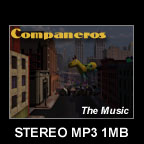 "Companeros"
is one of the pieces that plays at the Day of the Dead Festival in Year 1. The name
roughly means "comrades" and alludes to Salvador and his Lost Souls' Alliance,
since the festival takes place right above LSA headquarters. To me, all of the traditional
folk-sounding music in the game somehow connects to the LSA or to the Temple in Year 4,
either as Music of the People or as sacred music. The style is a sort of blend between
rural folk music and the sounds of a Mexican mariachi band. To get inspiration and
understanding of this kind of music, I did a lot of listening, both to recordings of
Mexican folk tunes, and to live mariachis. "Companeros"
is one of the pieces that plays at the Day of the Dead Festival in Year 1. The name
roughly means "comrades" and alludes to Salvador and his Lost Souls' Alliance,
since the festival takes place right above LSA headquarters. To me, all of the traditional
folk-sounding music in the game somehow connects to the LSA or to the Temple in Year 4,
either as Music of the People or as sacred music. The style is a sort of blend between
rural folk music and the sounds of a Mexican mariachi band. To get inspiration and
understanding of this kind of music, I did a lot of listening, both to recordings of
Mexican folk tunes, and to live mariachis.San Francisco has an area called the Mission District
which has an incredible mix of Latin and Anglo-American cultures. Depending on the club
you walk into, you can hear live swing, salsa, modern jazz, acid jazz, punk rock, folk,
blues and mariachi bands nearly any night of the week. Most of the musicians who played on
the Grim Fandango sound track either live in the Mission District and play these clubs
regularly, or were found through contacts I made there. The mariachi musicians who perform
in "Companeros" are among these. The band includes trumpet, violin, guitar, a
small tenor guitar-like instrument called the vihuela, as well as a beautiful bass
guitar called the guitaron.
-Peter McConnell |
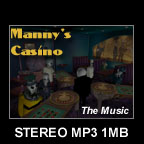 The Casino Interior music can be found in Manny's
casino (in Calavera Cafe) in Year 2, Rubacava. For use in the game, this piece was
filtered to sound like it might when played through the cafe's sound system. (As you can
see, we aren't strict about having technology from a certain period in Grim Fandango!).
You'll also hear just a bit of this music in the cutscene that introduces Year 2.
In classic film noir, Casinos are
often portrayed as lively nightspots; I wanted to create a feeling of almost carefree
decadence, just a bit edgier than the mood evoked by Rick's Cafe in the film Casablanca.
Casino Interior was based partly on the sounds of early Duke Ellington (circa late 1920s)
and partly on the small Benny Goodman ensembles that were popular during World War II. (I
was definitely thinking of Goodman in the clarinet part). Most of the piece was played by
live musicians who are steeped in this kind of music. I think they really make the track
speak. -Peter McConnell |
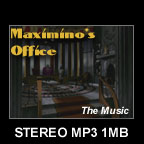 This piece is called Swanky
Maximino, and It plays in the office of Maximino, the gambling kingpin in Year 2. I
wanted to evoke the sounds of speakeasies of the Prohibition Era, those of the smaller
"big" bands that played in clubs in such places as Harlem in the heyday of the
Thompson gun-toting gangster. Maximino to me is an archetypal gangster character, a man
who prides himself on having arrived in the world, and he has spared no expense in decking
out his gambling club to show it. The music he would listen to, and the kinds of bands he
would hire to play at the club, would reflect that sense of opulence as well. The main
part of the music is inspired by recordings of the early Ellington band, when the Duke led
the musical part of the Harlem Renaissance in the late twenties. The bridge, or middle
section of the tune, is inspired by the aristocratic sound of bands you might hear in the
old Thin Man movies of the early thirties. For the most part, we used live musicians for
this recording, and I think they did a great job of capturing the style and musical feel
of that era. Their use of period-style mutes and plunger effects on the trumpet and
trombones is to me particularly authentic, and gives the tune a comic kind of menace,
perfect for Maximino's personality. This piece is called Swanky
Maximino, and It plays in the office of Maximino, the gambling kingpin in Year 2. I
wanted to evoke the sounds of speakeasies of the Prohibition Era, those of the smaller
"big" bands that played in clubs in such places as Harlem in the heyday of the
Thompson gun-toting gangster. Maximino to me is an archetypal gangster character, a man
who prides himself on having arrived in the world, and he has spared no expense in decking
out his gambling club to show it. The music he would listen to, and the kinds of bands he
would hire to play at the club, would reflect that sense of opulence as well. The main
part of the music is inspired by recordings of the early Ellington band, when the Duke led
the musical part of the Harlem Renaissance in the late twenties. The bridge, or middle
section of the tune, is inspired by the aristocratic sound of bands you might hear in the
old Thin Man movies of the early thirties. For the most part, we used live musicians for
this recording, and I think they did a great job of capturing the style and musical feel
of that era. Their use of period-style mutes and plunger effects on the trumpet and
trombones is to me particularly authentic, and gives the tune a comic kind of menace,
perfect for Maximino's personality.
-Peter McConnell |
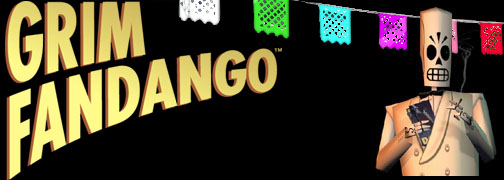

![]()
![]()
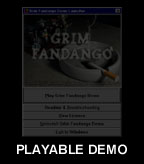
![]()
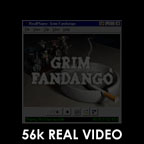
![]()